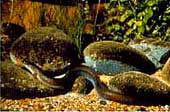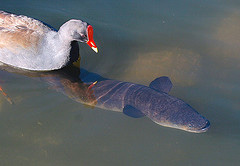 Click To Return To Main Page |
 |
||||||||
 News |
 Eco-Journalists |
 Articles |
 Games |
 Links |
 Facts 'n Fun |
 Email Us |
 About Us |
 Guestbook |
|
|
Endangered Eels
Head of Australian short-finned eel
photo © 2004 Nathan Litjens  It's not often that we think about eels! Maybe this is why Australian eels are now getting close to being endangered.
It's not often that we think about eels! Maybe this is why Australian eels are now getting close to being endangered.
The main reason is that when new housing developments are being built, dams, ponds and creeks are drained and the eels need these to survive. Not only do they need them to live in, but they also need to have many waterways available nearby so that they can travel to big rivers and on out to the sea. Australian long-finned eel
photo by Tony Eldon, of DOC, NZ  Believe it or not, eels actually crawl across land to get to other ponds and rivers. They can slither quite some distances (up to 400 metres). They do this to ensure that they are not trapped in a pond which is drying out and they also need to 'pond hop' to reach the ocean where all eels mate.
Believe it or not, eels actually crawl across land to get to other ponds and rivers. They can slither quite some distances (up to 400 metres). They do this to ensure that they are not trapped in a pond which is drying out and they also need to 'pond hop' to reach the ocean where all eels mate.
However, when the creeks, ponds and drains are demolished to make way for urban development, the eels lose a link on the way to ocean. Sometimes this may even trap the eels because they can't crawl far enough and could have been depending on that pond or creek to get there. Their breeding grounds are a long way off, in fact they have to swim down our rivers, out into the ocean and keep swimming until they reach the Coral Sea (off the coast of New Caledonia). Because only some of the eels are managing to find their way to the breeding grounds, the eel numbers are becoming dangerously low. Once the adult eels give birth, they die. The young eels (elver) then return to the pond which one of their parents originally lived in. It is believed they are able to recognise the particular water chemistry of their parents pond and somehow find their way back to it. The journey can take the elvers up to 3 years and only about 1% make it through the whole life cycle. Once in their Australian pond or river, they grow and mature so they too can one day begin the process of migrating (travelling) back to the Coral Sea to breed. In Australia, there are two types of eels which live in freshwater (not salty like the sea). The Long-finned (Anguilla reinhardti) and the Short-finned (Anguilla Australis) eel. The main difference is that the long-finned is much larger. The Longfinned eel grows up to 2 metres and can weigh over 15kg; they used to grow up to 40kg but the commercial fishing of eels has wiped out the big ones. They live to around 30 years, but it's now thought that they can live much longer. Australian Long-finned eel under a duck!
photo by Chi-lui  They live in lakes, dams, rivers and creeks. They are great survivers! They can live in water which has low levels of oxygen. They can get 50% of their oxygen by breathing it through their skin - this is why they are able to travel overland for such distances. They hibernate in winter when the water temperature drops below 10 degrees centigrade by sleeping in the muddy bottom. They can also live in mud for a while if their pond dries-up. They can live out of water for around 48 hours!
They live in lakes, dams, rivers and creeks. They are great survivers! They can live in water which has low levels of oxygen. They can get 50% of their oxygen by breathing it through their skin - this is why they are able to travel overland for such distances. They hibernate in winter when the water temperature drops below 10 degrees centigrade by sleeping in the muddy bottom. They can also live in mud for a while if their pond dries-up. They can live out of water for around 48 hours!
Eels can move with great determination and will overcome almost any obstacle to get to their destination. They can even climb up vertical walls. At Warragamba Dam, they have installed plastic spines on the walls surrounding the dam to help the elvers climb back overland to the dam water on the otherside of the river. The groundsmen at my school say that early in the morning, you can see the tracks the eels make when they slither up the slope from our one dam and across the oval to the other dam. Eels are carnivorous (they eat meat). They eat fish, frogs and even small birds (which explains the disapearing number of baby ducks at my school!) When we were on holiday in New Zealand, a park ranger took us to see an eel. This eel had a passion for cheese, especially camembert! He called for the eel just like you would a dog, the eel came and took the camembert from the ranger. Don't try this at home, eels have a bed of incredibly sharp teeth! What can you do to help the survival of eels? -To help the eels diminishing numbers, you can help with the regeneration of lakes and ponds to make them fit for aquatic life. Anything which makes sure the water is clean will help. You could join a streamwatch program to make ponds cleaner for eels. -Or, if there are not many ponds or creeks near you, and you have a larger property, you could build your own because the eels are sure to find it if they need it. Alastair Wadlow
Thank you to:
Tony Eldon of the Department of Conservation, New Zealand; Nathan Litjens and Chi-Lui for the use of the photos of the eels. www.nativefish.asn.au/sfeel.html www.faunanet.gov.au/wos/factfile.cfm?Fact_ID=390 www.answers.com/topic/short-finned-eel New Zealand Department of Conservation |